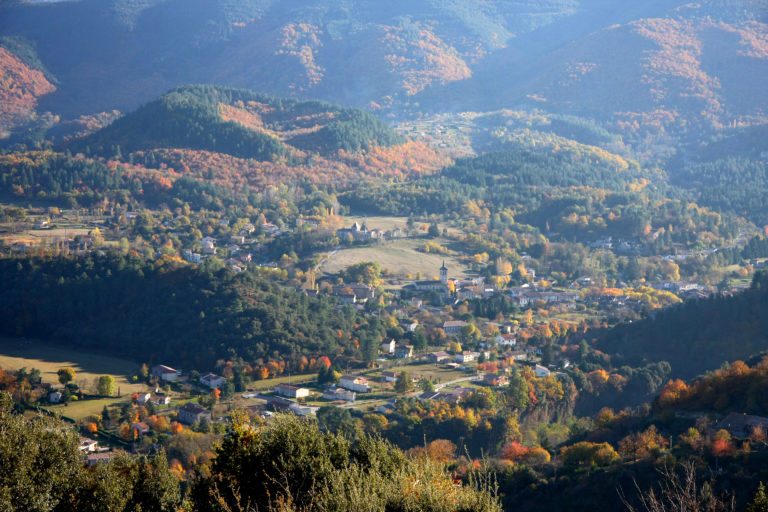Potential Classification : Geosite of the UNESCO Global Geopark of the Ardèche Monts
Managing Organization : Regional Natural Park of the Ardèche Monts
Presentation :
The Jaujac volcano is a Strombolian volcano resting on the Carboniferous strata, the single flow of which removed the crater from its crust. The characteristic horseshoe shape is open to the north. Slag is present along the leading path to the summit of the volcano. It is possible halfway to observe “pseudos flows”, or scoriac rocks. Certain masses of lava would have been projected at low altitude then would have sunk on the slope before cooling.
By taking the road towards St-Cirgues-de-prades, it is possible to observe the outer side of the volcano on the site of the former Laulagnet quarry. The side of the mountain shows the different products emitted during eruptions in the form of strata (slag, red lapilli).
The lava flow, for its part, rests in part on the Prades-Jaujac coal basin, which also allows some paleontological observations, the other being on the crystalline base. It borrowed at the end of the course the Lignon course which reformed its bed by incising the flow, revealing the basaltic prisms. The different stages of organ formation (real colonnade, entablature and false colonnade) are clearly visible from the bed of the stream.
Upstream of Jaujac, it is possible to observe different types of rocks on both sides of the river : left bank, the basalt organs from the flow, and right bank, the metamorphic rocks. From Jaujac, on the right bank is the flow, and the left bank is the metamorphic basement. The lava flow, blocked downstream by the Souilhol, flowed back a few meters into the Motte stream, and basalt organs are also observable there. The beaches are made up of alluvium and large blocks of granite and migmatite from the Lignon watershed, carried by the river. The basalt prisms cut by the river show enclaves of peridotites.
The site concentrates a variety of rocks of different natures : metamorphic rocks (different granites, migmatites), volcanic rock (basalt), alluvium. This variety enables the observation of different crystals. The site offers the possibility of understanding the different forms of erosion depending on the nature of the rocks.
Scientific or educational interests :
The Jaujac cup is one of the most representative volcanoes of Strombolian volcanism in Ardèche because of its very characteristic and well-preserved shape ; in a fairly short time, it is possible to make several observations : view of the volcano as a whole and its flow from the village, observation of the slag cone…. Note that the Jaujac flow and its prism formation is considered to be one of the most beautiful in Europe. The Jaujac volcano was also one of the very first studied in France.
Thematic keywords : conservation of collections, ecology, forest, geography, sedimentary geology, geomorphology, hydrogeology, hydrology, impact on tourist numbers, mines (old galleries), ornithology, paleontology, landscapes, 3D digitization topology, territorial sciences, volcanology
Keywords typology of sites : volcanic site, panorama reading landscapes, agricultural or pastoral zone, mediation space
Access modalities :
Free access all year round, possibility of having rooms available.
Possible support : Support possible by the Parc des Monts d’Ardèche team or a member of the Scientific Committee of the UNESCO Global Geopark.
